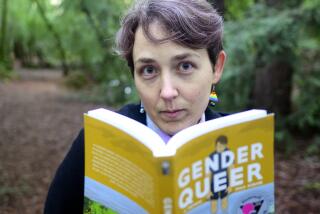FIRST FICTION
Rumble, Young
Man, Rumble
Benjamin Cavell
Alfred A. Knopf: 194 pp., $22
The rumbling young men of Benjamin Cavell’s astonishing story collection are jocks and jerks, boxers and boyfriends, paranoids and paintballers. They’re the kind of dudes who leg press 400-plus pounds, dose themselves with creatine and Rogaine, obsess about their manhood, get their heads occasionally knocked in and worry that some fool might toss a handful of pennies off the roof of a skyscraper and kill them.
Like Logan Bryant, the sporting goods salesman and military simulation hobbyist of the hilarious “Balls, Balls, Balls,” they can tell you all you need to know about the “Hicap 180-round front-loader with Trimount sight rail and TF90 reflex sight.” (It’s a weapon that fires paint, not bullets.) They’re nothing if not detail oriented: They can explain how to make napalm from gasoline and orange juice or how to drill a tiny hole in a gas main in order to blow up a house. They’re up to their meaty necks in a kind of hostile hyper-reality: ever at war, ever under siege, and always, it seems, a few lock steps out of pace with the world of workmates, wives and family.
Cavell gives us modern men as action figures, and each story brilliantly bends them into yet another bizarre pose. In “Evolution,” an apparently normal guy flirts with putting the theory of natural selection into practice when he plots the death of his girlfriend’s father. “The Art of the Possible” tells of a golden boy politician, nearing 30, hopped up on benzedrine and applying serious spin control to his marriage: “You give her the medium smile with the left corner of your mouth curled up, which she finds charming.” And “The Ropes” is the surprisingly tender story of a collegiate boxer recovering from a concussion on Martha’s Vineyard, amid Land Rovers, debutantes and his dad, a former pugilist.
Like this parade of manly men, Cavell’s prose is rude, manic, calculating, over-the-top, often hilarious and utterly surreal. There are echoes of the comic crudeness of Matthew Klam, the elegiac machismo of Thom Jones and the egg-headed weirdness of George Saunders, all contemporary heavyweights. If “Rumble, Young Man, Rumble” tends to be formulaic in its aggressive anthropology, continually jabbing at the same point, Cavell -- in these pungently original stories -- has made himself a legitimate contender.
*
Liars and Saints
Maile Meloy
Scribner: 270 pp., $24
Maile Meloy is the author of the accomplished story collection “Half in Love.” It’s no surprise, then, that each chapter of her highly anticipated first novel, “Liars and Saints,” has the seductive aura of a finely crafted story. Taken together, these episodes interlock to form a potent miniature saga that tells the story of the Santerres, a French Catholic family living in California, beginning with Teddy, a World War II fighter pilot, and concluding with little T.J., the current Santerre, a boy whose lineage is as tangled and improbable as those late 20th century decades that spawned him.
The surface of Meloy’s prose is serenely imperturbable. All the better for delivering the bombshells that come with credulity-challenging regularity throughout “Liars and Saints”: There is as much secrecy as there is love among the Santerres and, in fact, lying and saintliness tend to blur together as we learn about the family’s intimate, and often unarticulated, brushes with illegitimate offspring, simmering suspicion, sibling rivalry, occasional drug use, incest and, always, the Catholic Church.
To offer further details would give away far too much of Meloy’s considerable dramatic thunder, and you’d also never believe it. There are more twists and turns here than in “The Thornbirds” or even “All My Children,” and yet Meloy somehow makes every sentence of this book wholly believable. This is fearless, unapologetic melodrama, put across with evanescent insight and hard-won sentimentality.
“Liars and Saints” is a telescopic survey of five decades -- from the emotionally strangled ‘50s to the bland ‘90s -- that is instructive and bittersweet and yet somehow never nostalgic. And Meloy’s Santerres may just be the most fascinating, engrossing American family since the Louds.
More to Read
Sign up for our Book Club newsletter
Get the latest news, events and more from the Los Angeles Times Book Club, and help us get L.A. reading and talking.
You may occasionally receive promotional content from the Los Angeles Times.







